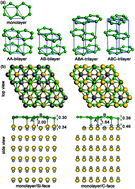Graphene layers on Si-face and C-face surfaces and interaction with Si and C atoms in layer controlled graphene growth on SiC substrates
Abstract
It is important to understand the interface and interaction between graphene layers and SiC surfaces as well as the interaction of key intermediate Si and C atoms with these surfaces and interfaces in epitaxial graphene growth on SiC substrates. In this study, we used the DFT-D2 method, which includes critical long-range van der Waals forces in graphene–SiC interaction, to study interface and interaction between mono-, bi-, and trilayer graphene and Si-face and C-face of SiC substrates as well as single Si and C atom interactions with these surfaces and interfaces. Our results show that the interface, which includes the bottom layer of graphene and top layer of SiC, has a major reconstruction due to the strong interaction of C–Si or C–C covalent bonds. The interaction energy of graphene bottom layer with the C-face is significantly lower than that with the Si-face, although there are stronger C–C covalent bonds and shorter interlayer distances at the graphene–C-face than that at the graphene–Si-face. In contrast, the interaction energy of second layer with bottom layer of graphene on the C-face is obviously higher than that on the Si-face. In particular, the top two layers almost float on the bottom layer of trilayer graphene on the Si-face. Furthermore, the bottom layer on Si-face with a metallic surface is more chemically active than that on the C-face with a semiconducting surface. Compared with the interaction of Si and C atoms with these surfaces and interfaces, the results show that Si atom has a stronger interaction with both bare Si-face and C-face than the C atom. Moreover, the interactions of Si and C atoms with bare Si-face are stronger than that with bare C-face. More importantly, once SiC surfaces are covered by a first carbon layer, C atom prefers to stay at the interface between the existing carbon layer and Si-face or C-face rather than on the surface of the existing carbon layer. In contrast, Si atom only prefers to stay on the surface of the existing carbon layer, and not on the interface. The difference in Si and C atoms on this issue may result in the epitaxial growth of new carbon islands or layers at the interface between the existing carbon layer and Si-face or C-face. All these findings provide insight into the controlled growth of epitaxial graphene on SiC substrates and the design of graphene–SiC based electronic devices.


 Please wait while we load your content...
Please wait while we load your content...